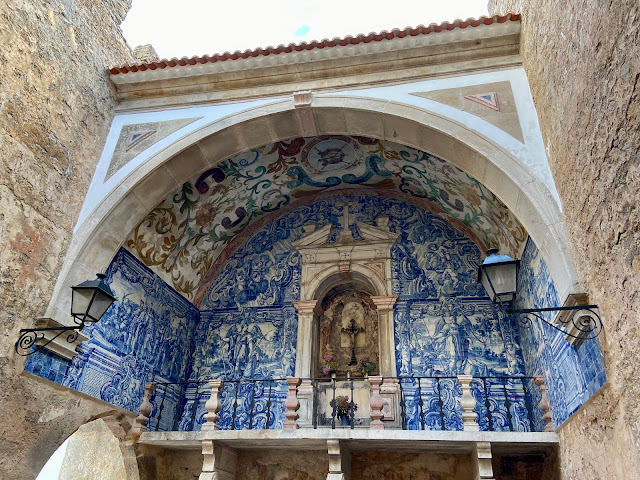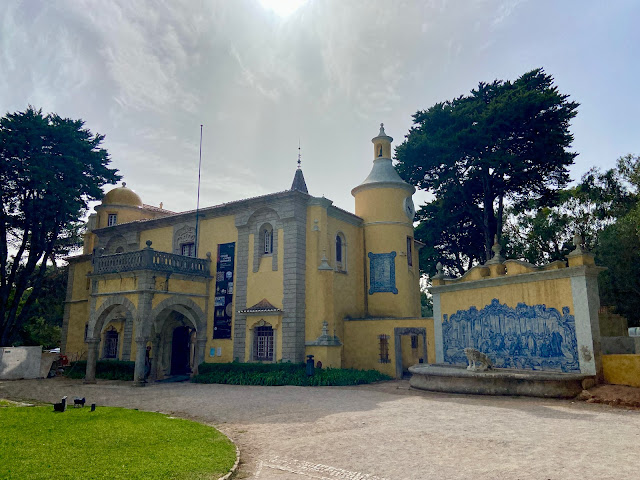Various friends are traveling from the US to Portugal. We use these occasions to consider the concept of the return trip – the 're-visit'. In his romantic and philosophical novel,
Night Train to Lisbon,
Pascal Mercier writes about 'going back':
We leave something of ourselves behind when we leave a place, we stay there, even though we go away. And there are things in us that we can find again only by going back there.
We expect to see familiar things, new things, and familiar things in a new way. Plus, traveling with friends allows us to share perspectives and understand a place with fresh eyes.
As an example, before departing on our day trips, we spend a day exploring Lisboa, and find ourselves at the
Castelo de São Jorge (Sep 14th, first visit
June 15th, 2017). In the center tower, there is a
camera obscura, which on all previous visits had been closed – in any case it always seemed a strange place to insert such a feature. Today it is open, and the operator, by manipulating cables and mirrors, takes us on a full tour of the sites of sunny Lisboa while standing in a dark room. Though still incongruous, its purpose becomes slightly more clear.
Batalha – Mosteiro da Batalha (Sep 15th, first visit
Feb 22nd):
The end of the summer is the start of 'repair season'. As we saw in
Queluz, parts of the
Mosteiro da Batalha are closed for repair and restoration. The while the church and the
panteão are open, the main cloisters are wrapped in scaffolding and netting. Still, the chapter house with the
Túmulo do Soldado Desconhecido, and the
refeitório with the museum are open.
We wait to see the changing of the guards – still inspiring to witness. And the monastery still tells a powerful story, despite the repair work. In terms of architecture, iconography, and character, it is uniquely Portuguese. It may be one of the best introductions for tourists to Portugal, as a nation and as a people. The towering scale and power of the 'Church' is balanced by the personal marks left in the floor by the masons. The pantheon of kings and queens stands in celebration and glory on one side, and the tomb of the unknown expresses the pain and perseverance on the other.
The saida is no longer from the near archway of the back cloisters (Claustro de Dom Alfonso V), but through the far archway, and into a brand-new gift shop – quite the tourist upgrade.
The Capelas Imperfeitas are open, too, but the rotunda is roped off. We are left to stand in the grand archway and regard the infinite height and the intimate details from a distance.
There is no big wave competition today;
Nazaré is wearing its 'resting face'. We take the opportunity to walk to the lighthouse, which is inaccessible during the competitions. We pass the souvenir stalls near the
Ermida da Memória and down the
Estrada do Farol. The
farol sits atop the
Forte de São Miguel Arcanjo, a fractured, uneven structure that seems to be excavated from the strata of the escarpment. The
farol is bright red, but is otherwise a modest fixture at the far corner.
From the Forte, the views to the Praia do Norte are stunning. For our past trip, the beach was littered with participants, surfing equipment, and emergency vehicles, but now it is unspoiled – the streaming clouds, the foamy coast, the smooth sand, and the empty dunes all curving to the east.
Inside the Forte, there are displays explaining the wave-generating, sub-surface topography, as well as garishly amusing surf art. Views back to the village and the crescent-shaped shore are equally captivating, with the cliff's craggy fringe in the foreground.
In
previous journeys to
Óbidos, the walled-city's famous
azulejos balcony, at the
Porta da Vila, was hidden during a years-long restoration. Though we were able to peer through the shuttering and watch as conservationists cleaned the surfaces, today we finally see the result.
Though the gatehouse stonework dates from the fourteenth century, the tile panels and balcony are Baroque, from the mid-eighteenth century. The decorative features disguise the defensive functions of the offset doors and the constricted passage. In the center is a small altar with a crucifix, though the back surface of the niche seems to be carved in that by-gone age.
The panels themselves shows scenes of the
Paixão de Cristo, the
Agonia de Jesus no Horto and the
Prisão de Jesus at the sides. In the roundel, in the center of the beautifully painted ceiling arch, is a crown of thorns, a
Christogram, and what appear to be a hammer and three nails. These all float in a simulated arrangement, and are enclosed by an oculus open to the heavens.
From our research, other video bloggers recommend that if you cannot see every site in
Sintra,
skip the Castelo dos Mouros. We are back
after several earlier visits, but partly due to this advice, we have never made it to the
Castelo. As soon as we arrive and step up to the parapet, we know those online reviews are garbage (unless you have small kids) – what a place.
As at
Monsanto, the walls spring up from the boulders on the ridge, but the scale is vast. The spine runs for several hundred meter (yards), between peaks at the northeast and the southwest, and with the city below to the north. A group of towers marks each summit. First, we follow the parapet to the northeast.
The fortifications date, obviously, from the time of the Moors (eighth and ninth centuries), but are the result of a series of reconstructions during the nineteenth and twentieth century. Though there are railings in key places, the drops are still vertigo-inducing.
Flags fly from each bastion and tower, representing the line of Portuguese monarchs since the
Reconquista, and we wonder about the folks who have to raise them.
The structure to the northeast is the Alcáçova (Torre de Menagem) or citadel (keep). The views over the roller-coaster walls south toward the Palácio da Pena and north to the Palácio Nacional are breathtaking.
Climbing back to the southwest, we reach the
Torre Real, resting on the higher peak, where
Dom Fernando II (
jure uxoris) is said to have enjoyed painting.
We hike down to one of our favorite lunch spots at
Tascantiga. To the east is a well-maintained, properly-paved path from the
Rampa do Castelo (near the
Igreja da Santa Maria) – on our first tour of Sintra, we used this to ascend to
Pena. Today, we take the shorter way to the north, known as the
Caminho da Vila Sassetti. Our online search offers snapshots of the
Caminho's paved 'top' (near the
Castelo) and 'bottom' (within the grounds of the
Vila), and so it looks very much like the way to the
Rampa. But the 'parts in between' are unpaved, unkept, and involve serious care and effort. It is, in parts, a sodden, steep slide.
We reach the village without injury. Apologies are made – blame is taken for the alarming descent, and credit is given for the amazing lunch spot.


Cascais – Museu Condes de Castro Guimarães (Oct 6th, first visit Nov 29th, 2021 – no blog post):
It stands over an inlet from the Atlantic (
Enseada de Santa Marta), and at the end of a large public park (the
Parque Marechal Carmona).
Manini's romantic and eclectic taste seems to have found the perfect patron in
Jorge O'Neill, an eccentric
Irish-Portuguese nobleman. This heritage is shown in the various shamrock patterns and heraldic devices throughout the house.
In 1910, the house is sold to the Counts of Castro Guimarães; then in 1924, it is donated to
the city of Cascais.
At the top of stairs, in the Torre de São Sebastião, the coffers of the ceiling proudly display the family crests. On the wall, a small framed 'family tree' explains the relationship of the branches. It's hard not to love the O'Hanlon crest, which is, quite simply, a pig in mud.
On the way out, we find a small gallery and library. There, under glass, is the
Crónica de el-Rei D. Afonso Henriques, a gorgeously illustrated manuscript that dates from sixteenth century. On the cover is a well-known image of
Lisboa in the Age of Discovery (
"evidenciando a topografia acidentada e a pujante atividade marítima dos Descobrimentos no rio Tejo").
We step outside to enjoy the
azulejos, the
Parque, and the lovely weather.
DEUS NOBIS HAEC OTIA FECIT – God has created this leisure for us (
Virgil, Eclogues 1:6).
Lisboa – Palácio dos Marqueses de Frontiera (Oct 10th, first visit
Sep 24th, 2019):
A gloomy day brings our return to the
Palácio dos Marqueses de Frontiera (seventeenth century). Luckily, the
guided tour takes us to the interior; unluckily, photos are not permitted. Our last guided tour was in Portuguese, and we are grateful for the English today, as we learn the colorful history of the
Távora family connection, which would never have been clear without translation:
Leonor Benedita, who herself was the fifth
Marquesa de Alorna, escaped execution for regicide and became the wife of the sixth
Marquês de Fronteira, thus uniting the Alorna and Fronteira titles.
Perhaps the best feature of the tour is the garden, which looks to be refreshed by the rains.
We never grow tired of
Belém. And though it's the middle of October, the grounds are jam-packed with tourists. It is the week of Columbus Day, and a national holiday in Spain (and other places), so that may explain crush – it was not this crowded during the summer. But it is still a wonderful area to explore, and certainly holds up to multiple visits.
Both the 'free' line to the
Igreja and the 'paid' line to the
Claustro look to be an hours-long wait. The
Jardim das Oliveiras is still fenced for 'after-summer' repairs. So we walk the perimeter to the underpass, and over to the
Padrão dos Descobrimentos. Just before midday, there is sun on both sides of the monument.
From the observation deck, our friends report that the Jeronimos lines are growing shorter. After a Portuguese lunch under the tents of the Rua Vieira Portuense we queue up. Getting through the Igreja is a piece of cake, just a few minutes in line – and actually, the queue clears as we depart. Maybe the lesson here is: go after lunch.
Vasco da Gama striveth hard to prove
that these old travels in world-song resounding
merit not glory nor men's hearts may move
like his sore travails Heav'en and Earth astounding.
Yes! but that Hero, whose esteem and love
crownèd with praise, prize, honours, gifts abounding
the Lyre of Mantua, taught her Bard to chaunt
Æneas' name, and Rome's high glories vaunt.
The Claustro is the highlight of any visit to Belém. As the crowd thins, the queue takes no more than a half hour. We always seem to catch the cloisters in the late afternoon, all the better for the sunlight sifting through the intricate screens, and casting on the warm stone vaults. As we have witnessed before, the sunset deepens, the rhythms pulse, and the archways begin to radiate. We share our favorite details: each symbol holds a meaning, each creature recites its own canto, and each voyage conveys new discoveries.






























































